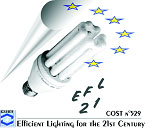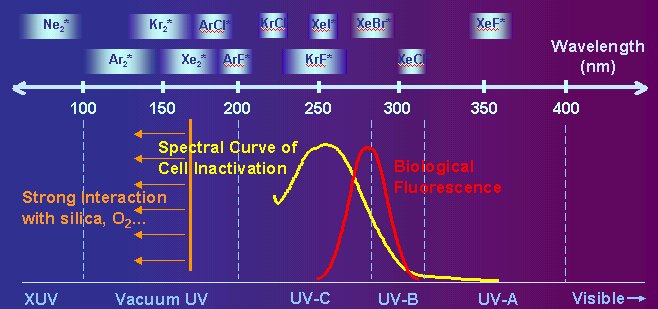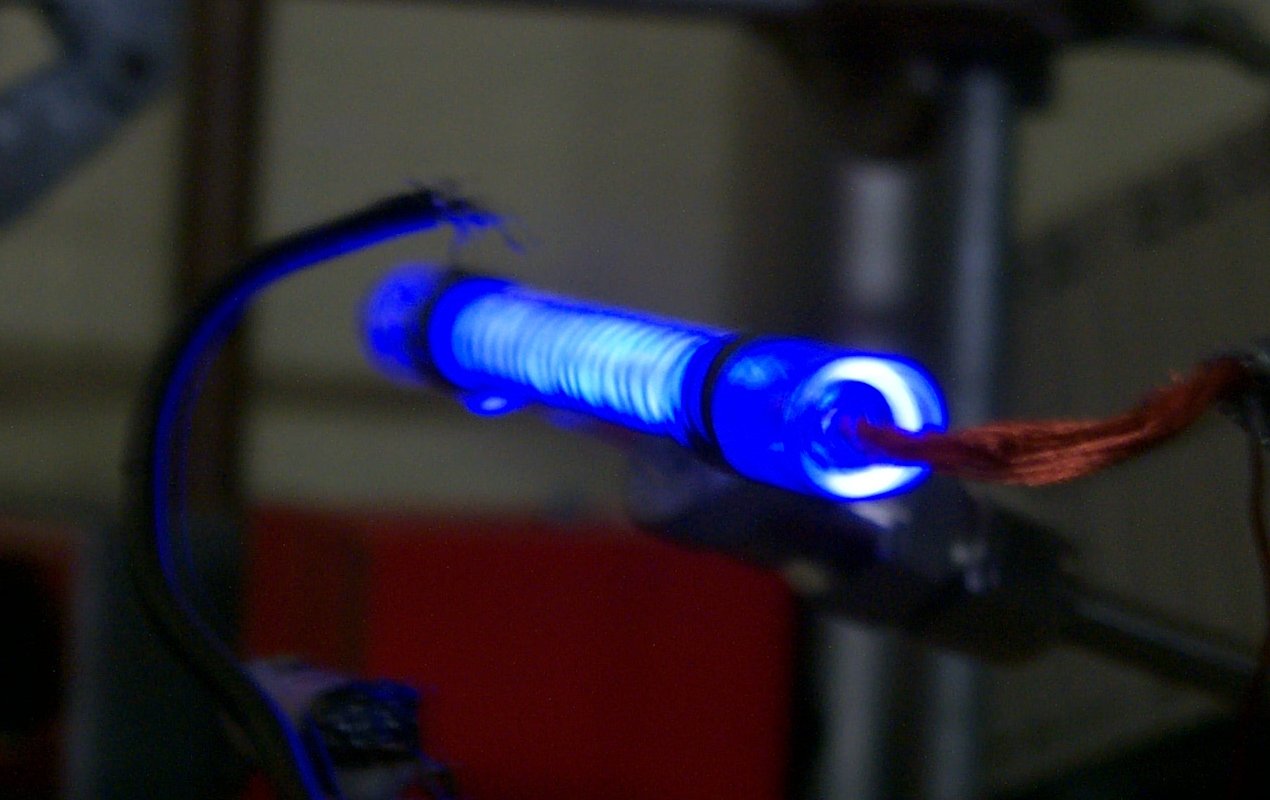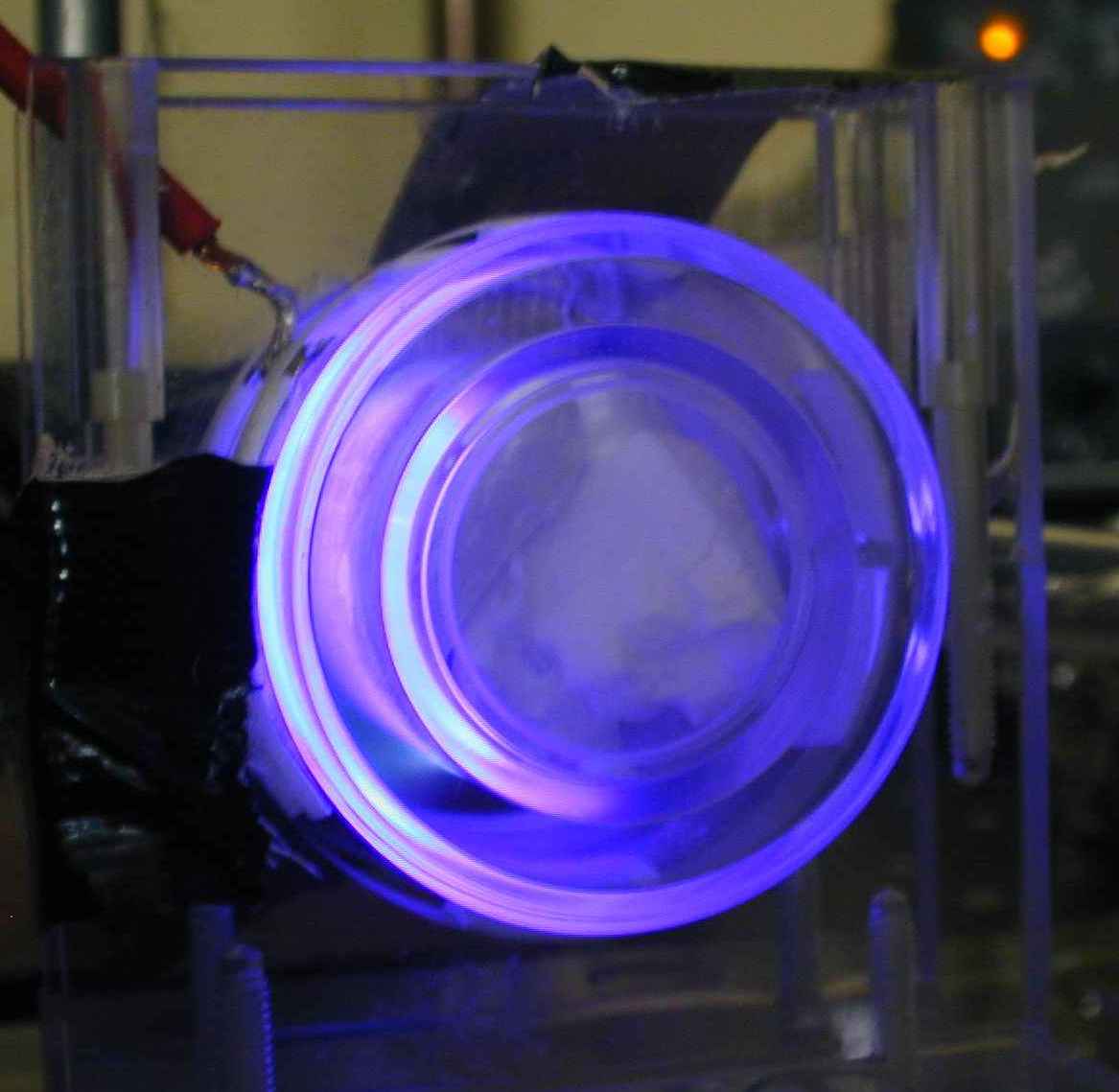

Associated Individual Member (non-EU) of the European Union funded, Cost Action 529 "Efficient Lighting of the 21st Century"
A description of current DBD lamp projects can be found here.
Short Wavelength Interactions with Matter (SWIM Group 2002-2005)


Associated Individual Member (non-EU) of the European Union funded, Cost Action 529 "Efficient Lighting of the 21st Century" |
Photon emission from the decay of rare-gas and rare-gas/halogen excimer molecules (eg. Xe,2*, Kr2*, Ar2*, XeCl*, KrCl*) form the basis of an important class of incoherent ultraviolet (UV) and vacuum ultraviolet (VUV) sources covering the range 80nm-350nm.

Sources with these wavelengths are already important for, but also have significant, unrealised potential for, applications in materials and environmental processing. Dielectric Barrier Discharge (DBD) source generate UV/VUV output from excimer molecules with very high electrical efficiency (~10-20%) using high-voltage AC excitation. In a DBD configuration one electrode (or both) is separated from the plasma by an insulating dielectric layer, and the discharge consists of a series of short-lived narrow filamentary channels or micro-discharges that occur stochastically in time. Although the vast majority of DBD lamps have traditionally been powered using AC voltage waveforms, short-pulsed excitation techniques have important advantages. In particular, the lamp efficiency for VUV production from a Xe2* lamp (172nm) can be dramatically increased by a factor of three (compared to AC excitation) by using fast excitation pulses of <1microsecond duration followed by “idle” periods (~100microsecs). The output is generated in short pulses of much higher peak power from homogeneous discharges or micro-discharges appearing as cone or funnel shaped structures (rather than narrow filaments).
Major projects completed to date include:
DBD Lamp for plasma diagnostic measurements


High-peak-power "finger" lamp @ 172nm
Cleaning and Surface Modification - We are currently investigating short-pulsed VUV sources for broad area surface treatments.
ICS Business Innovation - Lamp developments are available for licensing or for further collaborative development.
Postgraduate Research Opportunities
RP Mildren, DM Kane, RJ Carman, D Hirschausen and BK Ward, "Pulsed VUV Sources and their Application to Surface Cleaning of Optical Materials" to be presented at ILATA-2003 Symposium, St Petersburg, July 2003
R J Carman, B K Ward, R P Mildren and D M Kane, “Double discharges in bi-polar pulsed dielectric barrier discharge lamps in Xenon and their influence on the VUV (l=172nm) production efficiency, Proc. of the Tenth International Symposium on the Science and Technology of Light Sources, Toulouse, France, 18-22 July 2004, IOP Conference Series, number 182, ed G. Zissis, P-233, pp651-2, Institute of Physics Publishing, Bristol, UK, ISBN 0 7503 10073
B K Ward, R J Carman, R P Mildren and D M Kane, "Recent Advances in incoherent light sources in the vacuum-ultraviolet (88-200nm) based on electric discharge plasmas", Proc. of the 14th International Conference on Vacuum Ultraviolet Radiation Physics, (VUV XIV), Cairns, Australia, July 19-23 2004, paper Th-Po-144 p270, ed: B.R. Lewis, Research School of Physical Sciences and Engineering, Australian National University, Canberra, ACT
2004
R J Carman, R P Mildren, B K Ward and D M Kane, “High-pressure (>1 bar) dielectric barrier discharge lamps generating short pulses of high-peak power vacuum ultraviolet radiation”, J.Phys.D:Applied Physics, 37, (2004) (accepted)
R J Carman, B K Ward and R P Mildren “Reaction pathways in Xe*(1s4,5) excited-state to Xe2*(1,3S) dimer heavy-body conversion reactions in high pressure Xenon plasmas generated in dielectric barrier discharges”, The Thirteenth Gaseous Electronics Meeting incorporating the Italian-Australian Specialist Workshop on Plasma Treated Materials, Murruramarang Resort, Batemans Bay, NSW, Australia, Feb 1-5, 2004, p44, published by Macquarie University, ISBN 1864088818
R J Carman, D Hirschausen, B K Ward, R P Mildren and D M Kane "Optimisation of the pulse characteristics from Xenon dielectric barrier discharge vacuum-ultraviolet (l=172nm) flash-lamps for surface cleaning of optical materials", The Thirteenth Gaseous Electronics Meeting incorporating the Italian-Australian Specialist Workshop on Plasma Treated Materials, Murruramarang Resort, Batemans Bay, NSW, Australia, Feb 1-5, 2004, p11, published by Macquarie University, ISBN 1864088818
I S Falconer, R P Mildren and R J Carman “Dynamics of a homogeneous Dielectric Barrier Discharge in Xenon by short voltage pulses”, The Thirteenth Gaseous Electronics Meeting incorporating the Italian-Australian Specialist Workshop on Plasma Treated Materials, Murruramarang Resort, Batemans Bay, NSW, Australia, Feb 1-5, 2004, p31, published by Macquarie University, ISBN 1864088818
2003
R.J. Carman, B.J. Ward, R.P. Mildren, D.M. Kane, High-pressure dielectric barrier discharge Xenon lamps generating short pulses of high-peak-power VUV radiation (172nm) with high pulse-to-pulse reproducibility. 56th Annual Gaseous Electronics Conference 2003, October 21-24, San Francisco, CA (poster paper GTP.039)
R.J. Carman, B.J. Ward, R.P. Mildren, D.M. Kane, A Xenon dielectric barrier discharge lamp (172nm) with a fast-pulse voltage driver: Influence of the voltage waveform on plasma kinetic issues and light output, 56th Annual Gaseous Electronics Conference 2003, October 21-24, San Francisco, CA (oral paper MW1.007)
D.M.Kane, D.Hirschausen, B.K. Ward, R.J. Carman and R.P.Mildren, "Pulsed VUV sources and their Application to Surface Cleaning of Optical Materials”, Laser-Assisted Micro- and Nanotechnologies (LAMN X), 2003, Proc of SPIE, vol 5399, pp100-106, (SPIE Bellingham WA 2004).
R.J. Carman and R.P. Mildren, “Computer modelling of a short-pulse excited dielectric barrier discharge Xenon excimer lamp (l~172nm)” J. Phys. D:Appl. Phys., vol. 36, pp19-33, (2003)
2002
R.P. Mildren, R.J. Carman and I.S. Falconer, “Visible & VUV emission from a xenon dielectric barrier discharge using pulsed and sinusoidal voltage excitation waveforms” IEEE Trans Plasma Sci., vol. 30, pp192-193, (2002)
R.J. Carman and R.P. Mildren, “Computer modelling of electrical breakdown in a pulsed dielectric barrier discharge in xenon” IEEE Trans Plasma Sci., vol. 30, pp154-155, (2002)
R.P. Mildren, B.K. Ward and R.J. Carman, “High-peak-power VUV flashlamps based on short-pulse excited Xe dielectric barrier discharges”, Proc. XIV Int. Conf. on Gas Discharges and their Applications (GD2002), vol. 2, pp140-143, (2002)
B.K. Ward, R.P. Mildren and R.J. Carman, “Power scaling of VUV excimer DBD lamps”, Gaseous Electronics Meeting (GEM) , Batemans Bay, Feb 3-5, (2002)
R.J. Carman, R.P. Mildren, B.K. Ward, R. Morrow, I.S. Falconer and D.M. Kane, “New incoherent light sources in the vacuum-ultraviolet (VUV) based on pulse dielectric barrier discharges”, Gaseous Electronics Meeting (GEM) , invited paper, Batemans Bay, Feb 3-5, (2002)
R. Morrow and R.J. Carman, "A Two-Dimensional Model of a Xenon Excimer Dielectric Barrier Discharge", Twelfth Gaseous Electronics Meeting & Second International Workshop on Plasma Processing, Murruramarang Resort, Batemans Bay, NSW, Australia, Feb 3-6, (2002).
R.J.Carman, R.P. Mildren, R.Morrow and B K Ward, "Recent advances in Light Sources in the Vacuum-Ultraviolet based on electric discharge plasmas", 11th International Congress on Plasma Physics ICPP, Sydney, Australia, 15-19 July, 2002.
R.P. Mildren, B K Ward and R.J.Carman, "Efficient Vacuum Ultraviolet Lamps with Increased Irradiance", Australian Optical Society, Sydney, July 2002, p178, paper M-048-AOS, (Australian Institute of Physics).
2001
R.P. Mildren and R.J. Carman, “Enhanced performance of a dielectric barrier discharge lamp using short-pulsed excitation”, J. Phys. D: Appl. Phys. vol. 34, pL1-6, (2001)
R.P. Mildren, R.J. Carman, and I.S. Falconer, “Visible and VUV images of dielectric barrier discharges in Xe”, J. Phys. D:Appl. Phys., vol.34, no.23, pp.3378-82, (2001)
R.J. Carman, B.K. Ward and R.P. Mildren, “Short-pulse excitation techniques for performance enhancement in UV/VUV dielectric barrier discharge lamps”, Proceedings XXV International Conference on Phenomena in Ionized Gases (ICPIG), vol 4. Ed T. Goto, pp331-2, 2001
B.K. Ward, R.P. Mildren, R.J. Carman, I.S. Falconer R. Morrow, and D.M. Kane, “Novel excimer-based flash-lamp sources in the vacuum-ultra-violet”, Australian Conference on Lasers and Spectroscopy (ACOLs), Brisbane, Dec 2001
R.J. Carman, R.P. Mildren, R. Morrow and B.K. Ward, “A highly efficient Xe2* excimer flash-lamp source in the vacuum ultraviolet at 172nm: Computer modelling o fthe plasma kinetics in the dielectric barrier discharge”, Australian Conference on Lasers and Spectroscopy (ACOLs) , Brisbane, Dec 2001
2000
R.J. Carman and R.P. Mildren, “Electron energy distribution functions for modelling the plasma kinetics in dielectric barrier discharges”, J. Phys. D: Appl. Phys. vol. 33, pL99-103, (2000)
R.P. Mildren, R. Morrow, R.J. Carman, “Enhanced efficiency from a Xe excimer barrier discharge lamp employing short-pulsed excitation”, Proc. SPIE, vol.4071, pp.283-90, (2000)
R.J. Carman and R.P. Mildren, "A two-electron group model for the electron energy distribution function in a dielectric barrier discharge", Proc. Eleventh Gaseous Electronics Meeting (GEM XI), University of New England, Armidale, Australia, Jan 31-Feb 2, p17, (2000).
R.P. Mildren and R.J. Carman, "Short pulse excitation of barrier discharge lamps", Proc. Eleventh Gaseous Electronics Meeting (GEM XI), University of New England, Armidale, Australia, Jan 31-Feb 2, p33, (2000).
R.P. Mildren, I.S. Falconer and R.J. Carman, "Filaments and feelers: visible and VUV images of Xe dielectric barrier discharges", Plasma 2000, Australian Institute of Physics Congress, Adelaide, Dec. (2000).
1999
R.P. Mildren, R. Morrow and R.J. Carman, "A comparison of excitation methods for Xe excimer barrier discharge lamps", I-Vth International conference "Atomic and molecular pulsed lasers", Tomsk, Russia, Sept. 13-17, p41, (1999).
R.P. Mildren, R. Morrow and R.J. Carman, "A comparison of AC and short-pulse excitation for Xe barrier discharge lamps", Proc. 52nd Annual Gaseous Electronics Conference, Oct. 5-8, 1999, Old Dominion University, Norfolk, Virginia, Bull. Amer. Phys. Soc., vol 44, no.4, p18 (1999).
|
Physics@Macquarie home | Teaching | Postgraduate | Research | Student Services | Community Projects | HSC Students| Contact Us | Positions Vacant Web Enquiries to: Dr
Tony Farrow |